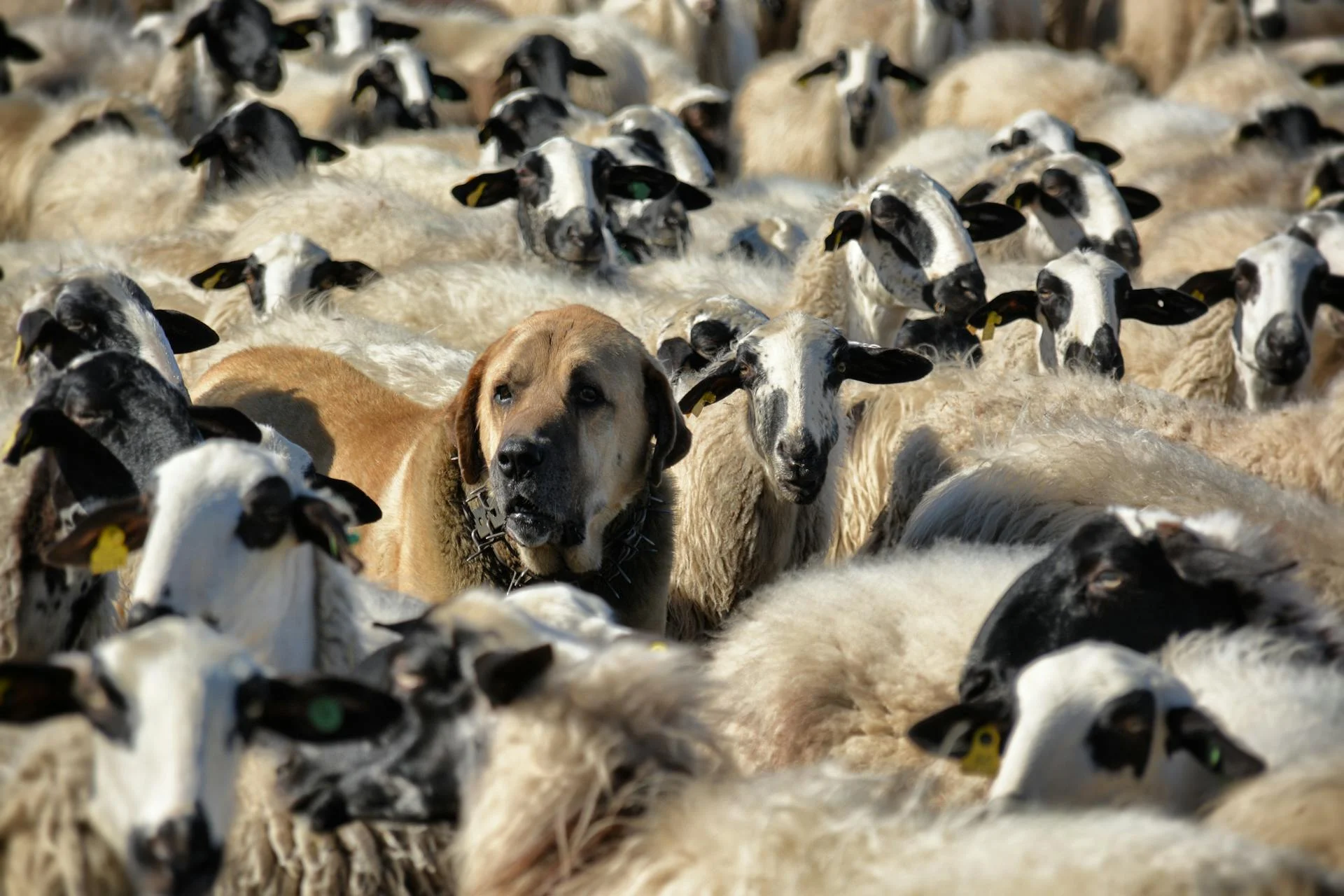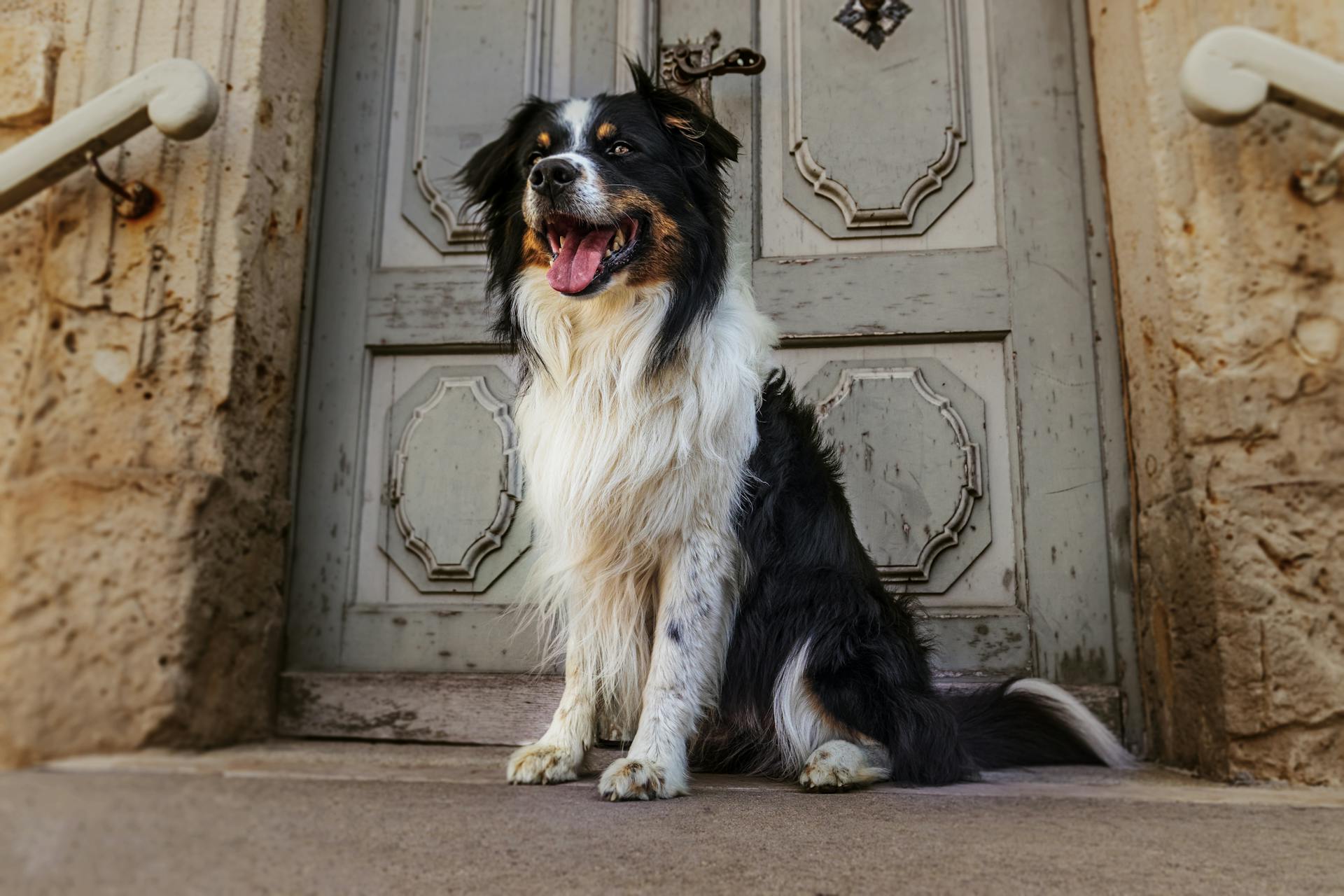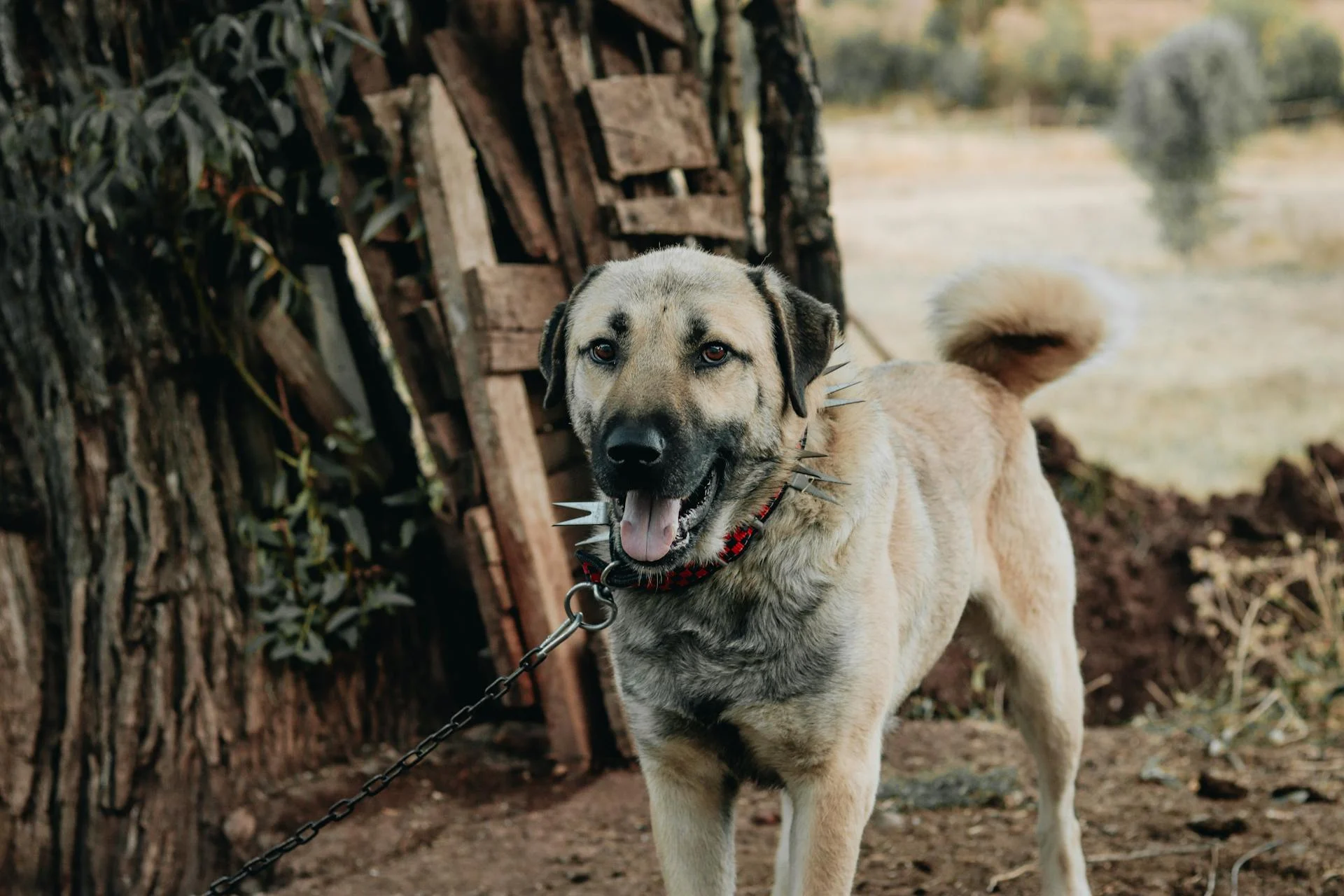
The Akbash dog breed is a majestic sight to behold, with its thick white coat and muscular build. They originated in Turkey and were bred to guard livestock.
Their large size is a testament to their purpose - they can weigh between 80-120 pounds and stand as tall as 30 inches at the shoulder.
Akbash dogs are naturally protective of their flock, but they are also gentle and even-tempered with their family.
Quick Facts
The Akbash breed originated in Turkey, where they were bred as livestock guardian dogs to protect sheep from predators like wolves. Their signature white coloring helped them blend in with the flock.
Akbash dogs are large, with males standing 28-34 inches tall and weighing 80-140 pounds. Females stand 26-32 inches tall and weigh 60-120 pounds.
Their coat is a medium-length double coat that sheds moderately year-round. Regular brushing is necessary to remove dead hair and prevent mats.
Akbash dogs have a high activity level and need plenty of exercise, both physical and mental. They also require regular grooming to stay healthy.
Here are some key health concerns to be aware of: hip dysplasia, elbow dysplasia, bloat, and eye problems.
Breed Overview
The Akbash breed is a unique combination of gazehound and Mastiff characteristics. They were bred in Turkey from sheepdog and sighthound stock to be a more watchful and independent guardian over livestock.
Akbash dogs are known for their physical strength and stamina, and they will do whatever it takes to protect their family and flock from danger. They have a white coat that helps them blend in with their flocks.
This breed is native to the plains and mountains of Western Turkey, where they were owned and bred by villagers and shepherds to protect sheep from predators like wolves. They were recognized as a distinct breed in the 1970s.
The Akbash is a protective breed, alert and intelligent, making them a great companion for the right family. They are not recommended for first-time or inexperienced dog owners.
Physical Characteristics
The Akbash Dog is a majestic breed with a distinctive physical appearance. They have a wedge-shaped head with pendant ears.
Their deep chest and long legs make them a striking sight. Males are typically taller and heavier than females.
Akbash Dogs come in a range of sizes, but they're generally on the larger end of the spectrum. They typically weigh between 75 to 140 pounds and stand between 27 to 34 inches tall at the shoulder.
Their coat is thick and double-layered, with a dense undercoat and longer, coarse guard hairs. The coat's thickness varies depending on the climate, but it's always a beautiful white color with some individuals having light biscuit or gray shading around their ears or in their undercoats.
Size
The Akbash is a large breed, typically weighing between 75 to 140 pounds.
Their size can vary, but on average, they have a shoulder height of 27 to 34 inches.
Some individuals may be smaller or larger than the average size, so it's essential to keep this in mind when considering an Akbash as a pet.
Their weight range is quite substantial, spanning over 65 pounds, which is a significant consideration for owners.
Related reading: Akbash Dog Size
Coat Color and Grooming

The Akbash breed is renowned for its striking white coats, which were purposefully developed to aid them as protectors of livestock and sheep. No other colors are accepted in the pure Akbash breed.
Their medium-length double coat sheds moderately, making regular brushing once or twice a week essential to remove dirt and old hair. Consistent grooming helps maintain their coat's condition, keeping it relatively easy to manage.
Akbashes may not be ideally suited for extreme weather conditions due to their longer coats. They shed heavily during the summer months, so you must make appropriate preparations to ensure their comfort and well-being.
Akbash Dogs have a thick double coat composed of a dense undercoat and longer, coarse guard hairs. The coat's thickness varies depending on the climate.
Their coat is non-smelling and non-matting, but regular grooming helps control the above-average shedding of the Akbash.
Distinctive Physical Traits
The Akbash Dog's head is wedge-shaped with pendant ears. This distinctive feature is one of the breed's most recognizable traits.
Males are typically taller and heavier than females, who have a notably feminine appearance.
A long tail that curls over the back is a key indicator of excitement in an Akbash Dog.
Temperament and Characteristics
The Akbash is a large, muscular dog known for its loyalty and strong protective instincts. They were originally bred as working farm dogs, which means they do best in a home where they have a job to do.
Akbashes are naturally prone to being dog-aggressive due to generations of guarding sheep against wolves and other wild animals. This is why it's best to keep them in a home without other dogs or small animals.
Despite their independent nature, Akbashes are gentle giants with a kind heart and enjoy spending time with their families. They make excellent family pets and get along well with kids.
Akbashes are highly intelligent and protective of their owners and homes, making them excellent guard dogs. They're also fast enough to chase off predators and independent enough to assess and respond to potential threats without guidance.
They're not hyperactive, but they do enjoy playtime and can learn to be polite in public with training. However, they prefer to be homebodies protecting their flock and enjoy their own time away from their owners.
Discover more: Livestock Guardian Animals
Akbashes tend to be suspicious of strangers and may act aggressively when an unknown dog enters their territory. Early socialization helps these pups grow into well-mannered adult dogs.
They mature slowly, so expect their "puppy phase" to continue into adulthood. With patience and consistent training, Akbashes can make loyal and devoted companions.
Health and Care
The Akbash breed is generally healthy, but like any large breed dog, they can be prone to certain health issues. Hip dysplasia, hypothyroidism, dilated cardiomyopathy, and gastric torsion (bloat) are some of the potential health problems that Akbash dogs may face.
Regular veterinary checkups are crucial for early detection of any health concerns. Your veterinarian can help create a comprehensive care routine tailored to keep your dog in optimal health.
Daily ear checks are essential to detect and remove debris and pests, and your vet can provide guidance on how to do this properly. Keeping your dog's nails trimmed once or twice a month is also crucial to prevent them from clicking on the floor.
Bloat is a very serious and potentially fatal condition that can be caused by a dog's stomach expanding with air and twisting. Small meals throughout the day, as well as elevated feeding bowls, can reduce the risk of bloat.
Akbash dogs may also be prone to hip dysplasia, which can lead to canine arthritis and joint degeneration if left untreated. Regular exercise, such as a daily walk, can help maintain your dog's joint health.
To ensure your Akbash's overall health and longevity, it's essential to stay vigilant and proactive in addressing potential health concerns. Regular health monitoring and early intervention can make a significant difference in your dog's quality of life.
The cost of caring for an Akbash can be significant, especially if your dog develops health conditions during their lifetime. Pet health insurance and pet savings accounts can be great options to help offset surprise veterinary costs.
Here are some common health problems that Akbash dogs may face:
- Hip dysplasia
- Hypothyroidism
- Dilated cardiomyopathy
- Gastric torsion (bloat)
Feeding and Diet
Akbash dogs are prone to weight gain if overfed, so it's essential to stick to a regular feeding schedule and avoid leaving food out throughout the day.
Their dietary needs change from puppyhood to adulthood and senior years, so it's best to consult with your veterinarian for personalized diet recommendations.
Akbash dogs benefit from a moderate protein intake of 22% to 28%, but puppies may need up to 32% or beyond.
They do well on a nutritionally balanced dog food formulated for large breeds, which helps prevent weight gain and gastric dilation.
To prevent bloat, feed your Akbash multiple small meals a day rather than one or two larger meals.
Their deep chests make them more susceptible to bloat, so it's crucial to take preventive measures.
You can help prevent bloat by breaking your dog's food up into several meals a day and using a food bowl designed to slow their eating.
Akbash dogs can tolerate a wide range of food, from meat and fish to bones, but it's essential to avoid overfeeding.
Small portions and regular feeding of fresh meat can help maintain your Akbash's overall health.
Feed containing omega-3 fatty acids and antioxidants can be particularly helpful in preventing joint diseases in older Akbash dogs.
Owning and Caring
Owning an Akbash requires a long-term commitment to their health and well-being. Regular veterinary checkups are vital for early detection of health concerns.
To prevent weight gain, aim for at least one good half-hour to hour-long walk per day, interspersed with active play sessions and shorter walks. Your veterinarian can help create a comprehensive care routine tailored to your dog's needs.
Daily ear checks are essential to detect and remove debris and pests, following your vet's recommendations for cleaning. Keeping your dog's nails trimmed once or twice a month is crucial to prevent them from clicking on the floor.
Children and Pets
The Akbash is a fantastic breed for families with children, but it's essential to consider their large size and independent nature. They can easily handle the enthusiastic play of kids, but it's crucial to teach children how to approach and interact with them gently.
If you have a low-energy dog, it may gravitate towards adults or older kids who can engage in gentle play. This is because Akbashes are naturally wary of strangers and may take time to warm up to new people.
Establishing yourself as the pack leader early on is vital in training an Akbash, and this is especially true when it comes to interacting with children. Consistent training techniques and positive reinforcement will help your dog understand what's expected of them.
Socialization is key when it comes to introducing an Akbash to other pets, especially children. Introduce them slowly and calmly, and make sure they're familiar with other animals from an early age. This will help them form amicable relationships with other dogs and cats.
For more insights, see: Training Livestock Guardian Dogs
Owning Essentials
Owning an Akbash requires some essential items to ensure their comfort and safety. A strong and resistant leash is a must-have for walks in residential areas and on country roads.
Leashes with a length of 50 centimeters to 120 centimeters are recommended for adult Akbashs. This size allows for a comfortable walk without restricting your dog's movement.
Setting up a dog kennel in your garden is a great way to provide your Akbash with a sense of security and comfort. The kennel should be spacious enough and made of sturdy material.
Accommodating an Akbash in a car can be challenging, especially on longer journeys. A professional dog crate is a great investment to provide additional safety for both humans and dogs.
Regular veterinary checkups are vital for early detection of any health concerns in your Akbash. Your veterinarian can help create a comprehensive care routine tailored to keep your dog in optimal health.
Frequently Asked Questions
Is Akbash a Great Pyrenees?
The Akbash is actually a separate breed, not a Great Pyrenees, but it's a parent breed of the Akbash Pyrenees crossbreed.
Do Akbash dogs bark a lot?
Akbash dogs are prone to alarm barking, which can sometimes be excessive. With proper training and socialization, however, they can learn to bark less
Are Akbash dogs easy to train?
Akbash dogs are challenging to train due to their independent nature, requiring a handler who can think outside the box. Effective training requires a deep understanding of the breed's unique characteristics and needs.
Are Akbash dogs aggressive?
Akbash dogs can be protective and may become aggressive with perceived threats, but this is not necessarily an indication of inherent aggression. Proper training and socialization are crucial to manage their strong instincts and ensure a well-behaved companion.
Is Akbash a rare breed?
Yes, Akbash is a rare breed outside of Turkey, but its origins date back 3,000 years. This ancient breed was first introduced to North America in 1970.
Featured Images: pexels.com


